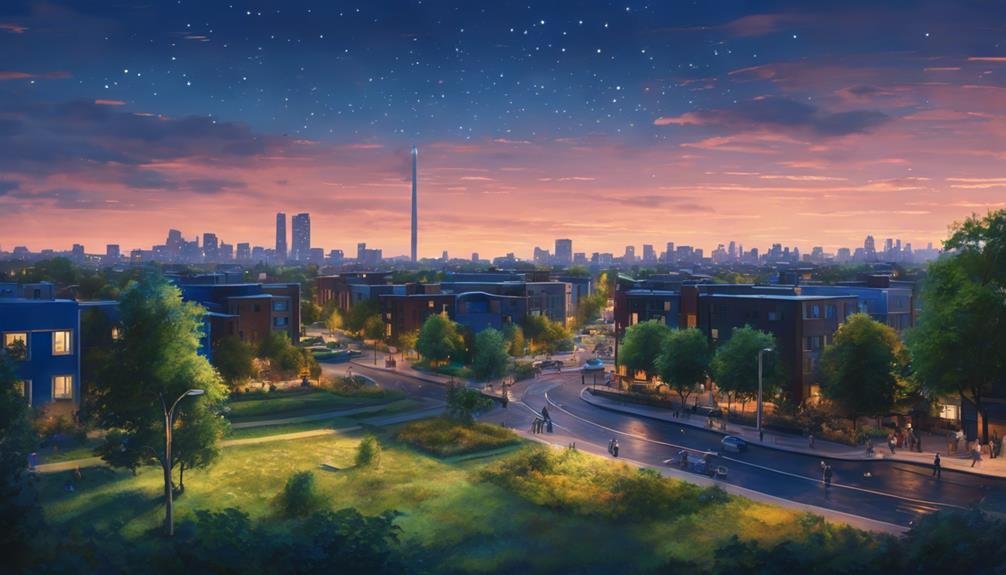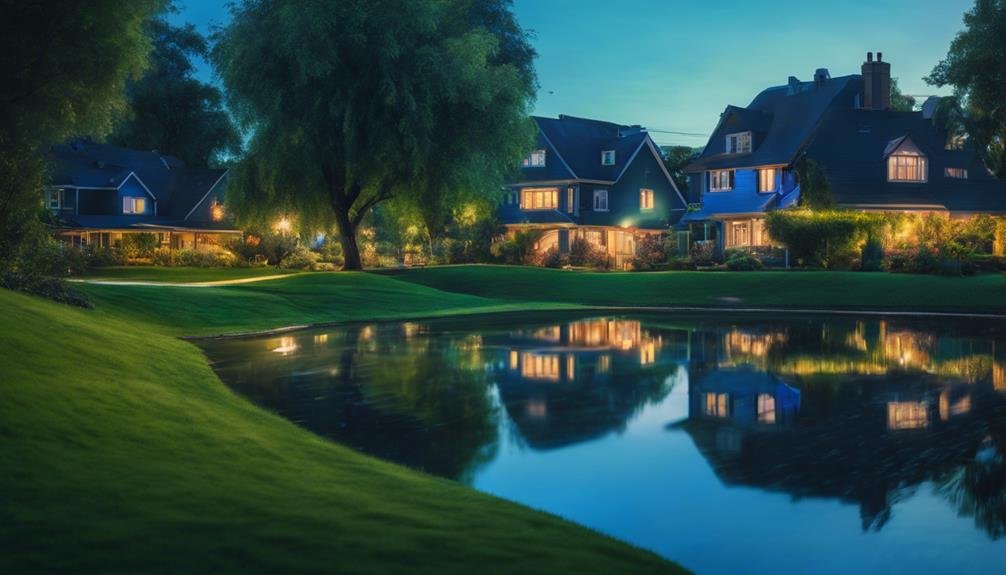A buffer zone in real estate is an area specifically designated to separate differing land uses, acting as a protective barrier. Its primary purpose is to improve compatibility between adjacent properties and mitigate adverse impacts such as noise, pollution, and visual disturbances. Buffer zones can include parks, green spaces, or gardened areas, improving aesthetics and promoting ecological sustainability. They also play a notable role in urban planning by contributing to community well-being and property values. Understanding the various types and regulations governing buffer zones can provide further understanding into their importance in real estate development.
Main Points
- A buffer zone in real estate is an area designed to separate different land uses, enhancing compatibility and reducing conflicts.
- It serves as a protective barrier that mitigates negative impacts like noise, pollution, and visual disturbances for nearby properties.
- Buffer zones can include landscaping, parks, and green spaces, improving aesthetics and recreational opportunities in urban environments.
- They positively influence property values by increasing appeal and perceived privacy for surrounding areas.
Definition of Buffer Zone
A buffer zone in real estate refers to a designated area that serves as a protective barrier between different land uses, mitigating potential conflicts and improving property values. These zones are strategically implemented to separate incompatible land uses, such as residential and commercial properties, or industrial areas from natural environments.
By establishing a buffer, developers and urban planners can reduce negative externalities like noise, pollution, and traffic, which may detract from the desirability of adjacent properties.
Buffer zones can take various forms, including parks, green spaces, landscaping, or even vacant land. The selection of the type of buffer depends on factors such as the specific land uses involved, local regulations, and community needs.
In addition to promoting a more pleasant living environment, buffer zones can also contribute to biodiversity by providing habitats for wildlife, thereby supporting ecological sustainability.
The effectiveness of a buffer zone is often influenced by its size, design, and location. A well-planned buffer can notably improve the appeal of a neighborhood, leading to increased property values and a higher quality of life for residents.
Conversely, poorly designed or inadequate buffer zones may fail to provide the intended protection, resulting in conflicts between land uses and diminished property values.
Importance in Urban Planning

Buffer zones play a critical role in urban planning by facilitating the harmonious integration of diverse land uses while minimizing conflicts that can arise from incompatible developments.
These zones serve as shifting spaces that help to mitigate the adverse effects of adjacent land uses, such as noise, pollution, and visual disturbances. By strategically placing buffer zones, urban planners can improve the quality of life for residents and guarantee sustainable development practices.
The importance of buffer zones in urban planning can be summarized through the following key points:
- Conflict Mitigation: Buffer zones act as barriers that reduce the impact of conflicting land uses, such as separating residential areas from industrial zones. This helps to alleviate issues related to noise, traffic, and pollution, leading to more pleasant living environments.
- Habitat Preservation: In urban settings, buffer zones can serve as essential habitats for local wildlife, contributing to biodiversity. These areas can be designed to maintain ecological balance while allowing for urban expansion, thereby promoting sustainable land use practices.
Types of Buffer Zones
Buffer zones can be categorized primarily into residential and commercial types, each serving distinct purposes within urban environments.
Residential buffer zones typically aim to reduce noise and improve privacy between housing developments and adjacent land uses.
In contrast, commercial buffer zones focus on mitigating the impact of business activities on surrounding areas, ensuring a harmonious coexistence between commercial enterprises and residential communities.
Residential Buffer Zones
Residential buffer zones serve as intermediate areas that mitigate the impact of different land uses, improving the quality of life for residents by providing separation from commercial or industrial developments.
These zones are strategically designed to encourage tranquility in residential neighborhoods, offering a shield against noise, pollution, and other externalities associated with more intensive land uses.
Common types of residential buffer zones include:
- Green Spaces: Parks, gardens, or natural settings that not only serve as aesthetic improvements but also provide recreational opportunities for residents.
- Fences and Walls: Physical barriers that create a sense of privacy and security, while also delineating property lines between residential and non-residential areas.
These buffer zones are essential in urban planning, as they help maintain property values and cultivate a sense of community by creating harmonious interactions between residential and non-residential developments.
In the end, well-designed residential buffer zones contribute greatly to the livability and sustainability of urban environments.
Commercial Buffer Zones
Commercial buffer zones play an essential role in urban planning by providing crucial separation between business activities and surrounding residential or recreational areas. These zones help mitigate the impact of noise, traffic, and visual disturbances generated by commercial developments, thereby enhancing the quality of life for nearby residents.
Typically, commercial buffer zones can include green areas, green spaces, or shifting uses such as offices or retail establishments that are less intrusive than industrial operations. The design of these buffer zones often incorporates features like noise barriers, fences, and trees to create a more pleasant environment.
In addition to improving aesthetics, commercial buffer zones serve practical purposes by reducing potential conflicts between different land uses. They can also contribute to improved property values in adjacent residential areas by providing a sense of tranquility and separation from busy commercial activities.
Furthermore, these buffer zones can encourage sustainable development by facilitating mixed-use areas where businesses and residences coexist harmoniously. By strategically implementing commercial buffer zones, urban planners can cultivate a balanced relationship between economic growth and community well-being.
Buffer Zones and Property Values

Establishing buffer zones can greatly influence property values by creating a shifting space that improves the appeal of surrounding areas. Buffer zones serve not only as physical separations but also as psychological barriers that augment the desirability of adjacent properties. These zones can mitigate negative impacts from nearby developments, such as noise pollution and visual disturbances, thereby cultivating a more pleasant living environment.
The presence of a well-maintained buffer zone can lead to several positive outcomes for property values:
- Increased Privacy: Buffer zones can provide a natural shield from neighboring properties, allowing for greater privacy and personal space, which many potential buyers prioritize when looking for homes.
- Improved Aesthetics: Landscaped buffer zones often include trees, gardens, or parks that contribute to the comprehensive beauty of the area. A visually appealing environment can attract buyers willing to pay a premium for properties that offer such amenities.
Environmental Impact Considerations

Buffer zones play a crucial role in mitigating environmental impacts by serving as intermediary areas that protect ecosystems and improve biodiversity. These zones act as a buffer between developed areas and natural habitats, reducing the adverse effects of urbanization, pollution, and land use changes on surrounding ecosystems. By maintaining a designated area of vegetation, buffer zones can filter pollutants, reduce runoff, and elevate water quality in adjacent bodies of water.
Additionally, buffer zones provide essential habitats for wildlife, creating corridors for species movement and encouraging genetic diversity. This is particularly important in urban settings, where fragmentation of natural habitats can lead to isolated populations and increased vulnerability to extinction. The presence of a well-planned buffer zone can also support the resilience of ecosystems, allowing them to modify to changes such as climate variability.
In addition to protecting wildlife, buffer zones contribute to the comprehensive health of the environment by improving soil stability and preventing erosion. They can also mitigate noise pollution and enhance air quality, benefiting both wildlife and human populations. Moreover, these areas can serve as recreational spaces for communities, promoting environmental awareness and stewardship.
Legal Regulations and Policies

Legal regulations and policies frequently dictate the establishment and maintenance of buffer zones, guaranteeing they effectively serve their intended environmental protection purposes.
These regulations are vital for mitigating the impact of urban development on natural ecosystems, as they create shifting areas that help preserve biodiversity and water quality. Local, state, and federal laws may govern the size, location, and specific characteristics of buffer zones, reflecting the unique environmental contexts and community needs.
In many jurisdictions, compliance with these regulations is enforced through zoning laws, land-use planning, and environmental impact assessments.
Key elements of these legal frameworks may include:
- Minimum Width Requirements: Regulations often specify minimum widths for buffer zones around water bodies, wetlands, and other sensitive areas, guaranteeing adequate protection against pollution and habitat disruption.
- Prohibited Activities: Certain activities, such as construction or clearing of vegetation, may be restricted within buffer zones to maintain their ecological integrity and prevent degradation.
Examples of Buffer Zones

Buffer zones in real estate serve various purposes, including residential, commercial, and environmental applications.
Residential buffer zones often separate housing developments from busy roadways.
Meanwhile, commercial buffer zones can mitigate the impact of industrial activities on nearby neighborhoods.
Additionally, environmental buffer requirements aim to protect natural resources and ecosystems from the effects of urbanization.
Residential Buffer Zones
In many residential areas, designated buffer zones serve to create a changeover space between different land uses, enhancing privacy and reducing noise for homeowners. These zones are strategically implemented to separate residential properties from incompatible uses, such as commercial or industrial developments. By doing so, they help maintain the residential character of neighborhoods while promoting harmonious coexistence among diverse land uses.
Examples of residential buffer zones include:
- Greenbelts: These natural areas, often composed of parks or landscaped strips, provide a visual and physical barrier between residential neighborhoods and commercial zones, mitigating noise and traffic disturbances.
- Fencing and Landscaping: Homeowners may employ tall fences or dense shrubbery to create a buffer that offers privacy and minimizes noise from surrounding properties, especially in densely populated areas.
Implementing these buffer zones is essential for encouraging a conducive living environment, contributing to property values and general community satisfaction.
Commercial Buffer Applications
Commercial buffer zones play a notable role in mitigating conflicts between business operations and surrounding residential areas by providing physical and visual separations that improve both privacy and operational efficiency. These zones can take various forms, tailored to the specific needs of the area and the types of businesses involved.
Here are some common applications of commercial buffer zones:
| Type of Buffer | Purpose | Example |
|---|---|---|
| Landscape Buffers | Improve aesthetics and privacy | Tree lines or shrubs separating a retail center from homes. |
| Noise Barriers | Reduce sound pollution | Soundproof fencing around industrial sites adjacent to residential neighborhoods. |
| Setback Requirements | Maintain distance from properties | Required space between a commercial building and nearby homes to limit disruption. |
Environmental Buffer Requirements
Environmental buffer zones are fundamental for protecting natural ecosystems and promoting biodiversity by providing significant separation between developed areas and sensitive habitats. These zones serve multiple purposes, including mitigating environmental impacts, enhancing wildlife corridors, and improving water quality. Various environmental buffer requirements are established based on local regulations, ecological considerations, and land use practices.
Examples of buffer zones include:
- Riparian Buffers: These areas adjacent to rivers and streams help filter pollutants, stabilize banks, and provide habitat for aquatic species.
- Wetland Buffers: Surrounding wetlands, these zones protect water quality and support diverse plant and animal life by reducing runoff and controlling sedimentation.
Implementing effective environmental buffer requirements is essential for sustainable development, as they help balance human activities with the preservation of critical ecosystems.
How to Identify Buffer Zones

Identifying buffer zones requires a thorough analysis of the surrounding land use patterns, zoning regulations, and natural features that contribute to the extensive spatial dynamics of a property. The process begins with a detailed examination of existing land uses adjacent to the property, evaluating how these uses interact with one another. This includes identifying residential, commercial, industrial, and agricultural areas, as well as any public spaces such as parks or schools.
Next, zoning regulations offer vital perspectives into permissible activities in the vicinity. Understanding local zoning ordinances helps in delineating areas where buffer zones may be mandated or recommended to mitigate potential conflicts between incompatible land uses. Additionally, natural features such as rivers, lakes, or wooded areas can greatly influence the establishment of buffer zones, as they may provide ecological benefits or serve as natural barriers.
To aid in the identification of buffer zones, the following table summarizes key factors to take into account:
| Factor | Description | Importance |
|---|---|---|
| Land Use Patterns | Analysis of surrounding properties | Determines compatibility of uses |
| Zoning Regulations | Local laws governing land use | Guides legal requirements for buffers |
| Natural Features | Presence of water bodies, trees | Influences ecological considerations |
| Proximity to Sensitive Areas | Locations like schools or hospitals | Guarantees protection of vulnerable populations |
| Community Input | Feedback from local stakeholders | Improves legitimacy and effectiveness |
Common Questions
How Are Buffer Zones Created in Real Estate Development?
Buffer zones in real estate development are typically created through strategic planning, land use regulations, and environmental assessments. These zones serve to mitigate impacts between differing land uses, enhancing community integration and promoting sustainable development practices.
Can Buffer Zones Affect Property Insurance Rates?
Yes, buffer zones can influence property insurance rates. These zones may mitigate risks associated with environmental hazards or urban development, potentially leading insurers to adjust premiums based on perceived safety and reduced liability for properties within such areas.
What Are Common Misconceptions About Buffer Zones?
Common misconceptions about buffer zones include the belief that they eliminate all risks, guarantee property value stability, and that their effectiveness is uniform across different regions. Understanding their specific applications is essential for informed decision-making.
How Do Buffer Zones Influence Community Health?
Buffer zones notably improve community health by mitigating environmental pollutants, reducing noise and traffic congestion, and promoting greenery. These areas encourage recreational opportunities, improve air quality, and create safe spaces, ultimately contributing to residents' comprehensive well-being.
Are Buffer Zones Permanent or Subject to Change?
Buffer zones are not fundamentally permanent; they can be modified based on evolving regulations, community needs, or environmental assessments. Continuous evaluation guarantees that buffer zones remain effective in addressing relevant concerns and adjusting to changing circumstances.
Conclusion
In summary, buffer zones play a vital role in real estate and urban planning by providing necessary separation between different land uses, thereby enhancing property values and ensuring environmental protection.
Various types of buffer zones exist, each serving distinct purposes based on location and community needs.
Legal regulations govern the establishment and maintenance of these zones, reflecting their importance in sustainable development.
Ultimately, understanding buffer zones is essential for informed decision-making in real estate and urban development contexts.

Leave a Reply